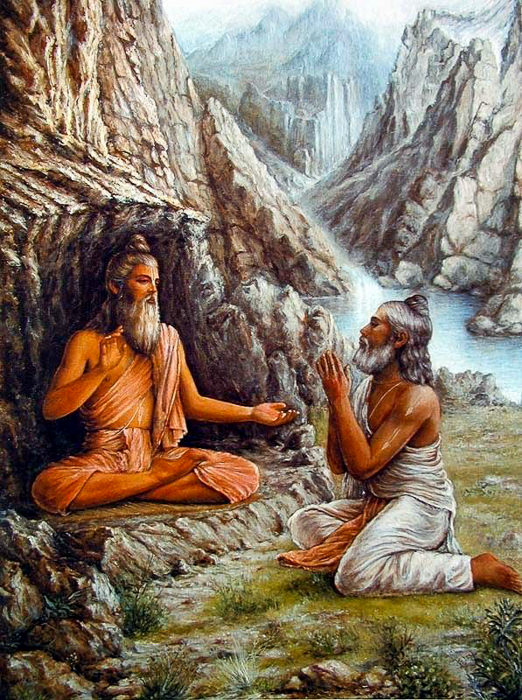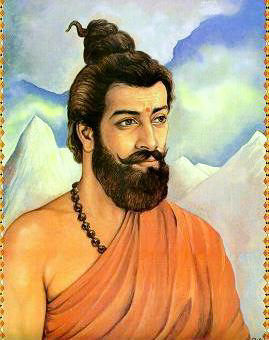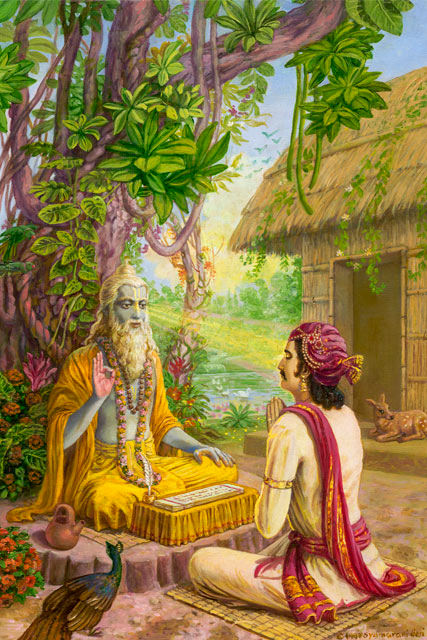Nyaya shastra
Nyaya-Sastra was founded by Gautama Rishi. He wrote 521 Sutras. These Sutras are divided into 5 parts with 10 chapters and 80 sub-chapters. Many authors wrote commentaries on his teachings, interperated his ideas and added new ones. Nyaya literally means Logic. It is applied as a logical method itself, not only to describe a system structured according to the rules of logic.
The teaching of Nyaya states that the suffering of human existence is caused by the cycle of death and rebirth. Re-birth occurs as a result of actions or deeds performed in previous lives. The cause for action lies in having both the desire for pleasant experiences and in the wish to avoid unpleasant ones. Wishes and aversions originate out of ignorance of the true nature of the human Soul, and its relationship to the body, as well as the other objects of creation.
True knowledge about the existence of the Soul as being non-different from the rest of creation dispels ignorance. The elimination of ignorance changes desire and aversion into happiness (Ananda) and grants freedom from Karma. In this way, knowledge leads to the end of rebirth and suffering of human existence.
Knowledge can be acquired through true sources of perception:
a) OBSERVATION
b) COMPARISON
c) DEDUCTION
d) TEACHINGS FROM THE MASTER
Detailed explanation of the rules of inductive and deductive logic follow, along with the cause and results. TWELVE OBJECTS OF PERCEPTION ARE:
- The Soul, different from human mind and body and all other created objects.
- The intellect or Buddhi, an attribute of the Soul not of the mind.
- The five sense organs of perception: seeing, hearing, feeling smelling and tasting.
- The five objects of the senses: ether, air, fire, water and earth.
- The five skills of contact of each sense organ with objects of the senses:
- hearing Ether with the ears
- touch of Air on the skin
- seeing Fire with the eyes
- tasting Water with the tongue
- smelling the Earth with the nose
- The human body consists of five objects of the senses: Earth, Water, Fire, Air, Ether.
- Karma or deeds.
- Positive or negative results of actions.
- Wish and rejection (Raga and Dvesa).
- Reincarnation
- Religion
- Realisation
This system of Indian philosophy acknowledges the existance of God as Creator of the Universe. The Universe must have a creator like any other object. The principle theme is Realisation of the true nature of the human Soul (Atma). God or Paramatma is different from the body and other created things and is considered omnipresent and all pervading. This principle describes a detailed atom theory of Matter.
Vaisheshika shastra
Founded by Kanada Rishi. He wrote 100 Sutras divided into 10 parts with 20 chapters. Many comments and interpretations followed. His original ideas were broadened with the addition of more Sutras. The name Vaisheshika has its origin in the word Visesh = difference. It means the different parts into which the human Soul and objects can be divided.
The aim of this philosophy is like that of the Nyaya Shastra. Salvation from suffering comes through Liberation of rebirth, wishes and ignorance.
This school also acknowledges the existence of God or of the supreme Soul, which permeates the whole Universe. The focus on the teachings of this system is on Realisation of the true nature of the Soul as different from all creation.
Kanada does not deal as much with logical explanations as Gautama, he tries to interpret things more from the scientific point of view. He says that time, space and Soul are external. Through concentration of the mind on the Soul, it is possible to attain liberation, all kinds of supernatural powers and knowledge of Reality, as well as knowledge of worldly matters and events.

Sankhya shastra
Its founder is Kapila Acharya, but his original works were lost. The word “Sankhya” means a number (cipher). This philosophy treats 25 elements. According to this system, Knowledge of the 25 elements of the Universe is essential in order to overcome the suffering of our existence and the difference between two these elements: PURUSHA (or Soul), and PRAKRITI (or nature). The Sankhya way of thought is:

When we are capable of analysing the elements of which the whole Universe consists, we come to the conslusion that our true Self is fundamentally different from the rest of the world, inclusive of body and mind. When we observe the natural laws of nature in the whole Universe we automatically become indifferent to physical and mental suffering, which are the cause of problems in human existence. According to Sankhya there are two external realities:
- Soul, or PURUSHA, the conscious external all pervading observer of the Universe,
- Nature, or PRAKRITI, the cause of creation.
There are three GUNAS (qualities) existent in the whole of nature:
- SATTVA representing purity, nature, harmony, rhythm and all that is good,
- RAJAS symbolising wishes, greediness, egoism and egocentrism,
- TAMAS meaning ignorance, stupidity, darkness and laziness.
All is attributed to these three forces of nature. They are in a state of balance prior to creation. First, the five elements, and then all sentient and insentient beings develop from these forces, through the union of PURUSHA (Soul) with three GUNAS (qualities). PRAKRITI – nature, in its unmanifest state, is in perfect balance with these three Gunas. Creation means the transformation of nature, PRAKRITI, through the process of evolution from the unmanifest into the manifest state. Development occurs step by step, from the subtle to the more gross matter. The dissolution of the Universe occurs in the opposite direction – coarse matter becomes more and more fine. The first to originate was the most subtle and finest of all matter. This fact explains the superiority of the SATTVA GUNA. The first created objects are called MAHAT which is the transition between unmanifest nature and the manifested world. It is called BUDDHI, or the „reason‟ behind creation. The original reason is not indivdual, rather Universal. Creation developed from MAHAT – the Universal reason behind AHAMKARA – the ego or divided individual being. PRAKRITI was transformed into MAHAT and MAHAT into AHAMKARA. Then came the mind and the five elements. They manifested according to the sequence of manifestation from the finest element (Ether) to the coarsest, (Earth). PRAKRITI is non-manifest. MAHAT is half manifested, the five elements and the creation are manifested. AHAMKARA, mind and senses, are manifested but not physically material like all the other objects of the Universe.
According to this philosophical system PRAKRITI, nature, is the cause of creation and PURUSHA, the Soul, is only the observer of this process. Purusha participates in creation only via the connection with nature (PRAKRITI), which contains all living beings and matter.
The twenty-five elements of the SANKHYA philosophy are:
PURUSHA – Soul, all-pervading
PRAKRITI – Nature
MAHAT – Universal intelligence
AHAMKARA – Ego, individual existence, self-consciousness
INDRIYAS – Senses of perception and of action.
The 11 INDRIYAS are:
MANAS – Central sense organ or the Mind. MANAS directs INDRIYAS – the organs of sense through the sense subconscious.
- MANAS – Central sense organ or the Mind. MANAS directs INDRIYAS – the organs of sense through the sense subconscious.
- The five senses of perception (Jnana Indriyas):
1. eyes – Caksu – seeing
2. ears – Srotra – hearing
3. skin – Tvak – feeling
4. nose – Ghrana – smelling
5. tongue – Jihva – tasting
- Five senses of action (Karma Indriyas):
1. mouth – Vani – speech
2. hands – Pani – action
3. feet – Pad – locomotion
4. reproductive organs – Upastha – procreation
5. Excretion organs – Guda – elimination
The five MAHA–BHUTAS (perceivable elements) have the quality of Tamas:
- Akasha – Ether
- Vaju – Air
- Tejas – Fire
- Apas – Water
- Prithvi – Earth
The five Bhutas combined with the five Jnana-Indriyas result in 25 apparent forms of distinctly separate forms in the Universe.
The five TANMANTRAS (subtle elements) are the types of perception of objects and matter through the organs of sense. They have the quality of Sattva:
- Sabda – Sound of ether through ears
- Sparsa – Touch of air on the skin
- Rupa – Sight of fire through the eyes
- Rasa – Taste of water through the tongue
- Gandha – Smell of earth through the nose
PURUSHA, PRAKRITI, MAHAT, AHAMKARA, 11 INDRIYAS, 5 BHUTAS and 5 TANMANTRAS form 25 elements of this philosophical system. PURUSHA is lively, conscious, eternal, endless, unchangeable, the observer and enjoyer of creation. Without being its creator PURUSHA stands above the three GUNAS: Sattva, Rajas and Tamas. PRAKRITI is eternal and limitless, it contains matter and living entities as well, it creates the Universe via its association with PURUSHA.
The human body consists of 2 sheaths (covers):
- The subtle body, consisting of MAHAT, AHAMKARA, 11 INDRIYAS and 5 TANMATRAS.
- The gross body, consisting of 5 BHUTAS – earth, water, fire, air and ether.
The subtle body does not die, and like the Soul, it too goes together with the ATMA to another body. Only the material (gross) body dies, ie. it dissolves again into the 5 elements which were its origin.
A very important aspect in the system of SANKHYA philosophy, are the three GUNAS. A perfect balance between the GUNAS exists prior to creation in PRAKRITI. After creation these qualities or forces express themselves in various combinations in man. Numerous characteristics arise according to the connection of the three qualities. If SATTVA predominates, we speak about a good character. If TAMAS predominates, the result is a bad character. The quality of the consciousness of each individual being depends on how the qualities of the three Gunas has combined.
Yoga shastra of Patanjali
his system was founded by Rishi PATANJALI. He wrote 195 Sutras, divided into 4 parts. Like the Sankhya school of thought, he wrote about the 25 elements, plus an additional one – God. PATANJALI recognised the necessity to know these 25 elements, but went even further. According to his teaching, the detachment of the Soul from nature (which is necessary in order to allow freedom from suffering), is possible. It is possible to reach this goal through the practise of Yoga techniques such as concentration and meditation, as described in detail in his Sutras. PATANJALI analyses and explores various states of the mind according to which guna is most predominant: good or SATTVIC, mixed or RAJASIC, bad or TAMASIC.
These three gunas exist in every individual being.

He describes techniques to achieve one pointed concentration and peace of mind. He speaks about obstructions on the path. He writes about the gradual progress of spiritual development and of his efforts on the path of Self-Realisation. PATANJALI defines YOGA as a technique to control the activity of the mind. He teaches that it is impossible to quieten the mind until the mind and its activities are thoroughly brought under control. This state is necessary for salvation. To reach this control of mind there are many obstacles like illness, pride, loss of enthusiasm, inability to concentrate, ingnorance, greediness, depression etc. The followers of his teaching should practise concentration and meditation daily, in divine virtue, to reach the desired aim. Patanjali names two very effective “weapons” to overcome obstacles on the path: ABHYAS or continual practise of concentration without paying attention to difficulties, and VAIRAGYA, the unceasing practise of equanimity towards the fruits of actions and unceasing endeavour despite repeated misfortune. PATANJALI describes and instructs exactly how to reach control of the mind by regulation and final cessation of breath. He provides rules and regulations on how to live one’s life, guidelines on the correct meditation position, on techniques of breath control, and on various objects of concentration eg. God, the Anahat Chakra, Ajna Chakra or the Sahasrar Chakra.
He describes the experiences and effects of the concentration and meditation exercises. PATANJALI speaks about numerous supernatural powers attained through the practise of concentration and meditation, such as the knowledge of the past, present and future, reading of thoughts, control of hunger and thirst, realisation of one’s true Self etc. Till finally, liberation of the Atma occurs. PANTANJALI warns of paying too much attention to these supernatural or psychic powers. Egoistic application of these powers hinders liberation (which is the only aim) of a true BHAKTA (devotee).
Patanjali describes the state of consciosness reached through concentration and meditation as follows:
- a quiet mind – through concentration on a certain object, or
- on the highest level, the mind partially stops its activities and is completely under control.
Samo to posljednje stanje uma vodi k stvarnom odvajanju duše od prirode, što i jest ljudski cilj – oslobođenje.
Mimansa shastra
Rishi JAIMINI wrote over 1,000 Sutras divided into 12 chapters. According to his philosophy, the only possibility to overcome suffering is to correctly practise the ceremonies as described in the VEDAS. For him the VEDAS represent an unchangeable truth and authority. The practise of VEDIC ceremonies without desire for result leads to liberation from rebirth. Therefore this philosophical system interprets the rules of ceremonies and explains their exact practise. As in the Nyaya Shastra, it explains the sources of true knowledge, ie. observation, hearing from others, conclusion of analogies, and the teachings of Sages. As in Vaisheshika Shastra, there are texts about the various types and qualities of matter and objects – their functions, similarities and differences. His work speaks, like previous ones, about body, mind, Soul, elements and the senses. A special value is attributed to sound. The unerring reality of sound, represented by the words of the Vedas, is the basis of his philosophical system. This school acknowledges laws of KARMA and rebirth however, God is not mentioned here like in Sankhya. Liberation is anticipated as a result of faithful performance of the ceremonies from the VEDAS. These ceremonies should be performed with perfect awareness of duty and without desire for the fruits of them. Here Liberation means a perfect, conscious happiness through Realisation of the true Self.
Vedanta shastra
Veda = the Vedas; Anta = end.
Vedanta has two meanings:
Knowledge transcending the Vedas (stretching beyond the Vedas)
The essence of the Vedas.
Vedanta means the end, completion or perfection of knowledge.
The philosophical school was grounded by VED-VYAS. He wrote 555 Sutras diveded into 4 chapters. There is only one possibility for humans to be liberated from the suffering of existence which, according to his teachings, is true knowledge about God, man, the Universe etc. as stated in the VEDAS and UPANISHADS.
The VEDANTA school is divided into three parts according to how they regard the relationship between God and the Universe:
1. Absolute Monism or Advaita
2. Relative Monism or Vishista Advaita
3. Dualism or Dvaita

Advaita
or the absolute monism acknowledges God as the only reality in the cosmos and considers the whole creation (all that is created) as unreal. There exists nothing else but one endless BRAHMAN. Creation appears to us as real due to our ignorance and this error becomes immediately obvious to us once ignorance is dispelled. SHANKARACHARYA who lived in the 8th century after Christ, was one of the most significant representatives of this philosophy. He put down the essence of VEDANTA philosphy in his work the “Viveka Chudamani” – the Jewel of Discrimination.
Vishista-Advaita
or relative monism, accepts God as a valid reality but acknowledges two other principles as reality: mind and nature (although it considers them as two aspects of the one). RAMANUJA from the 13th century, was the most significant representative of this system.
Dvaita
or dualism, postulates a separation between God and the Universe. This school teaches that the human Soul, however near it may come to God, can never unite with him. Mind and nature are two realities separate from God. MADHURA-ACHARYA from the 14th century, was a great philosopher of this school.
The Scriptures of ADVAITA are characterised by a brilliant logic and adhering proof. The relative monism is a kind of compromise between ideal logic and limited human knowledge. The dualistic school is an expression of devotion to God. Despite existing differences, all three schools hold to the basic teaching of the VEDAS and UPANISHADS.
The Vedanta philosophy is the last and the most common of the six philosophical systems in India. VYAS rejected the teaching of Sankhya that creation happens through PRAKRITI (nature) and its connection with PURUSHA (Soul). With reference to the VEDAS and UPANISHADS he explains that the Universe was created by God and directly from him with help of His divine MAYA.
Many philosophers wrote commentaries and interpretations on Vedanta. The most significant is that from SHANKARACHARYA. Shankaracharya adopted the theory of absolute monism – ADVAITA. For him there is only one reality – God. The Universe and the whole of creation are unreal. They only appear to be real through the power of divine Maya or Illusion. The creation of the world by God and from Him, may be compared to that analogy of the spider’s web. Within its own body the spider produces the substance for the web. Ignorance causes our error when we think the Universe is real. It is similar to the situation when somebody looks at a rope on the ground and sees it as a snake, or sees a mirror as water.
Knowledge or the perception of God uniting with creation, can be reached through the following three techniques:
- Studying or hearing the Holy Scriptures
- Meditation on the truth in these works
- Samadhi or Spiritual Union. In this state, the Truth is consciously experienced and realised.
Vedanta gives exact instruction about purification of the mind which makes possible Realisaton of the supreme Truth, God and the Universe. Following these instructions leads to Liberation.
